key RENAULT WIND 2012 1.G User Guide
[x] Cancel search | Manufacturer: RENAULT, Model Year: 2012, Model line: WIND, Model: RENAULT WIND 2012 1.GPages: 185, PDF Size: 5.52 MB
Page 67 of 185

starting the engine ................................ (up to the end of the DU)
starting the engine ................................ (up to the end of the DU)
2.3
ENG_UD29995_3
Démarrage / Arrêt moteur avec carte RENAULT mains libres (E33 - X33 - Renault)
ENG_NU_865-6_E33_Renault_2
Starting, stopping the engine
St ARtING/StoPPING thE ENGINE
Starting the engine
Engine warm or cold:
– Turn the ignition key to “Start” posi-
tion D without accelerating;
– release the key as soon as the
engine starts.
Special note: if starting the engine
when the outdoor temperature is very
low (below - 10 ° C): hold down the
clutch pedal until the engine starts.
Stopping the engine
With the engine idling, turn the key
back to “Stop” position St.
Driver’s responsibility
Never leave your vehicle
with the key or remote con-
trol inside the vehicle and
never leave a child (or a pet) unsu-
pervised, even for a short while.
There is a risk that they could start
the engine or operate electrical
equipment (electric windows etc.)
and trap part of their body (neck,
arms, hands, etc.).
Risk of serious injury.
Never switch off the ignition
before the vehicle has stopped
completely . Once the engine has
stopped, the brake servo, pow -
erassisted steering, etc., and the
passive safety devices such as
air bags and pretensioners will no
longer operate.
The steering is locked when the key
is removed.
Page 86 of 185
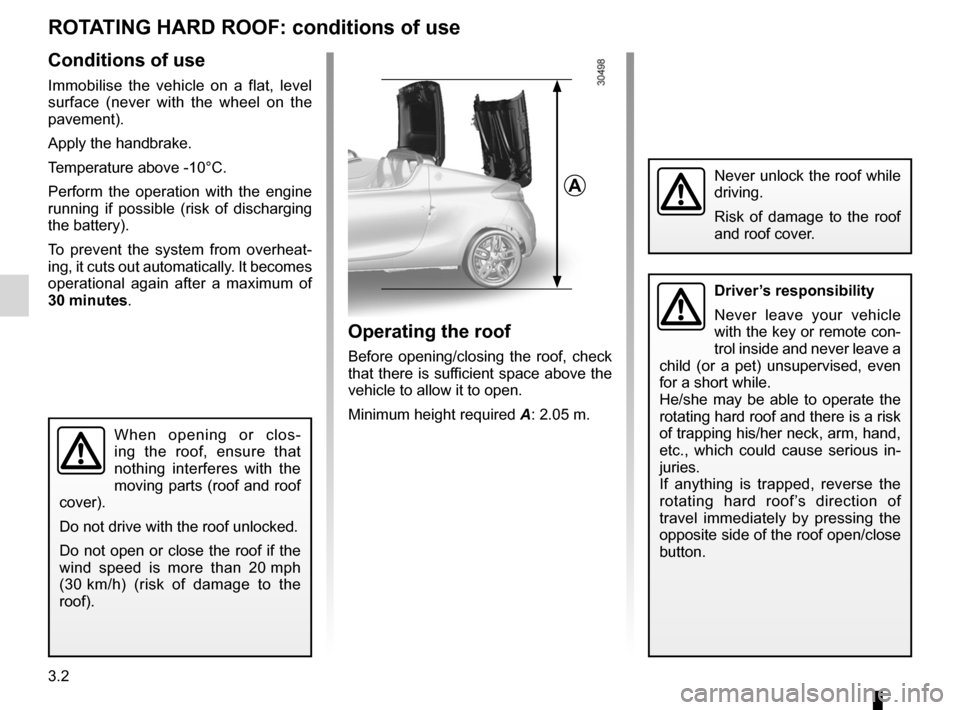
3.2
ENG_UD20475_2
Toit rigide escamotable : condition d’utilisation (E33 - X33 - Renaul\
t)
ENG_NU_865-6_E33_Renault_3
Rotating hard roof
Rotating HaRD RooF: conditions of use
Conditions of use
Immobilise the vehicle on a flat, level
surface (never with the wheel on the
pavement).
Apply the handbrake.
Temperature above -10°C.
Perform the operation with the engine
running if possible (risk of discharging
the battery).
To prevent the system from overheat -
ing, it cuts out automatically. It becomes
operational again after a maximum of
30 minutes.
When opening or clos -
ing the roof, ensure that
nothing interferes with the
moving parts (roof and roof
cover).
Do not drive with the roof unlocked.
Do not open or close the roof if the
wind speed is more than 20 mph
(30 km/h) (risk of damage to the
roof).
Driver’s responsibility
Never leave your vehicle
with the key or remote con-
trol inside and never leave a
child (or a pet) unsupervised, even
for a short while.
He/she may be able to operate the
rotating hard roof and there is a risk
of trapping his/her neck, arm, hand,
etc., which could cause serious in -
juries.
If anything is trapped, reverse the
rotating hard roof’s direction of
travel immediately by pressing the
opposite side of the roof open/close
button.
Never unlock the roof while
driving.
Risk of damage to the roof
and roof cover.
operating the roof
Before opening/closing the roof, check
that there is sufficient space above the
vehicle to allow it to open.
Minimum height required A: 2.05 m.
a
Page 88 of 185

3.4
ENG_UD20476_2
Toit rigide escamotable : anomalie de fonctionnement (E33 - X33 - Renaul\
t)
ENG_NU_865-6_E33_Renault_3
Jaune NoirNoir texte
Rotating HaRD RooF: operating fault (1/2)
the roof unlocks but does
not open
Check that the luggage compartment
lid is properly closed. Restart the oper-
ation: lock then unlock the roof without
pushing it upwards.
Repair procedure
If there is a system fault, you can close
the rotating hard roof.
To do this, open the roof cover manu -
ally.
Unclip logo 1 on the luggage compart-
ment lid.
12
Remove plastic cover 2 to access the
screw.Use the emergency key supplied in the
glove box to turn the screw clockwise
until the roof cover opens sufficiently
(point of resistance).
To avoid all risk of injury,
ensure that nobody is in
the proximity of the moving
parts.
When opening/closing the roof,
ensure that nothing interferes with
the moving parts (roof and roof
cover).
Ensure that there are no objects in
roof/roof cover area A.
a
Page 89 of 185
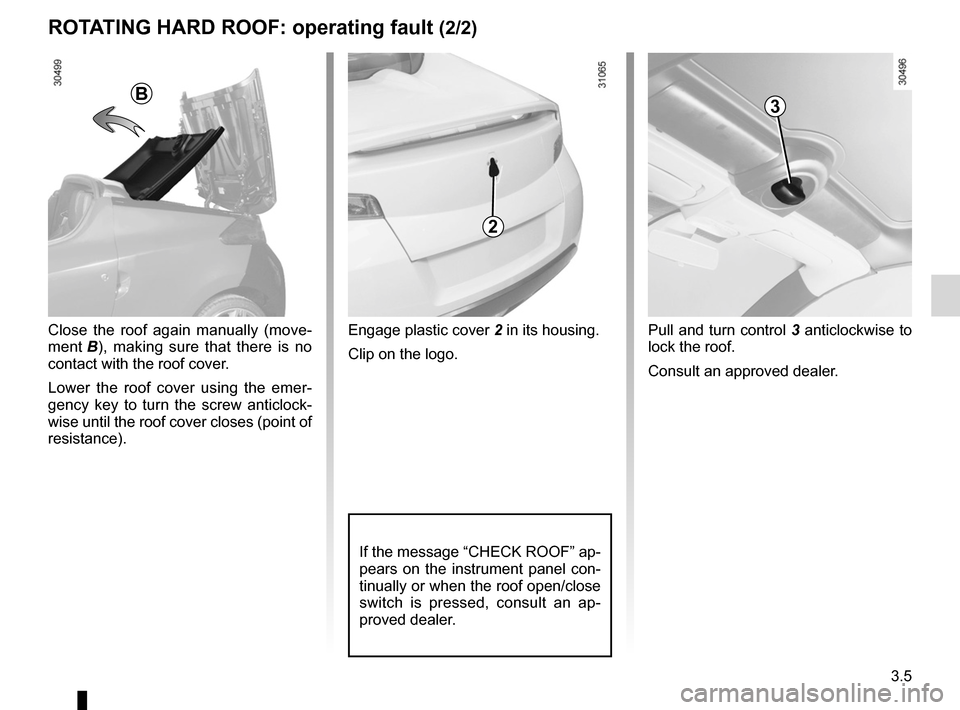
JauneNoirNoir texte
3.5
ENG_UD20476_2
Toit rigide escamotable : anomalie de fonctionnement (E33 - X33 - Renaul\
t)
ENG_NU_865-6_E33_Renault_3
Rotating HaRD RooF: operating fault (2/2)
Close the roof again manually (move -
ment B ), making sure that there is no
contact with the roof cover.
Lower the roof cover using the emer -
gency key to turn the screw anticlock -
wise until the roof cover closes (point of
resistance).Engage plastic cover 2 in its housing.
Clip on the logo. Pull and turn control
3 anticlockwise to
lock the roof.
Consult an approved dealer.
B
2
3
If the message “CHECK ROOF” ap-
pears on the instrument panel con-
tinually or when the roof open/close
switch is pressed, consult an ap -
proved dealer.
Page 103 of 185
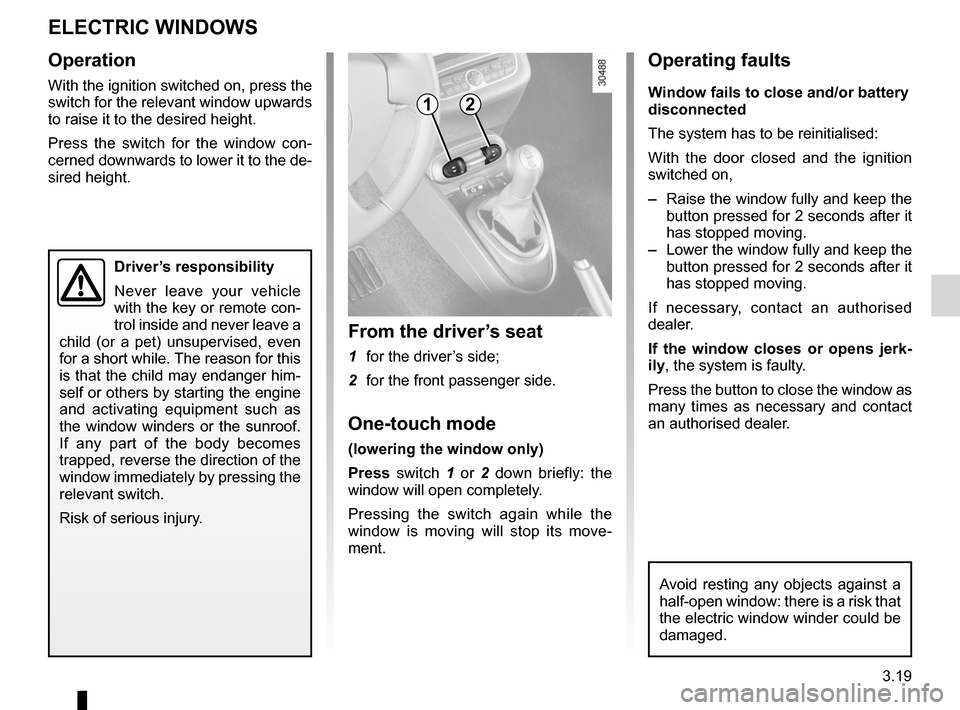
electric windows ................................... (up to the end of the DU)
child safety ............................................................. (current page)
children (safety) ..................................................... (current page)
sunroof .................................................. (up to the end of the DU)
3.19
ENG_UD24366_2
Lève-vitres électriques (E33 - X33 - Renault)
ENG_NU_865-6_E33_Renault_3
Electric windows
eleCtRiC winDows
operation
With the ignition switched on, press the
switch for the relevant window upwards
to raise it to the desired height.
Press the switch for the window con -
cerned downwards to lower it to the de-
sired height.
From the driver’s seat
1 for the driver’s side;
2 for the front passenger side.
one-touch mode
(lowering the window only)
Press switch 1 or 2 down briefly: the
window will open completely.
Pressing the switch again while the
window is moving will stop its move -
ment.
Avoid resting any objects against a
half-open window: there is a risk that
the electric window winder could be
damaged.
1
Driver’s responsibility
Never leave your vehicle
with the key or remote con-
trol inside and never leave a
child (or a pet) unsupervised, even
for a short while. The reason for this
is that the child may endanger him-
self or others by starting the engine
and activating equipment such as
the window winders or the sunroof.
If any part of the body becomes
trapped, reverse the direction of the
window immediately by pressing the
relevant switch.
Risk of serious injury.
2
operating faults
w indow fails to close and/or battery
disconnected
The system has to be reinitialised:
With the door closed and the ignition
switched on,
– Raise the window fully and keep the
button pressed for 2 seconds after it
has stopped moving.
– Lower the window fully and keep the
button pressed for 2 seconds after it
has stopped moving.
If necessary, contact an authorised
dealer.
i f the window closes or opens jerk -
ily, the system is faulty.
Press the button to close the window as
many times as necessary and contact
an authorised dealer.
Page 127 of 185
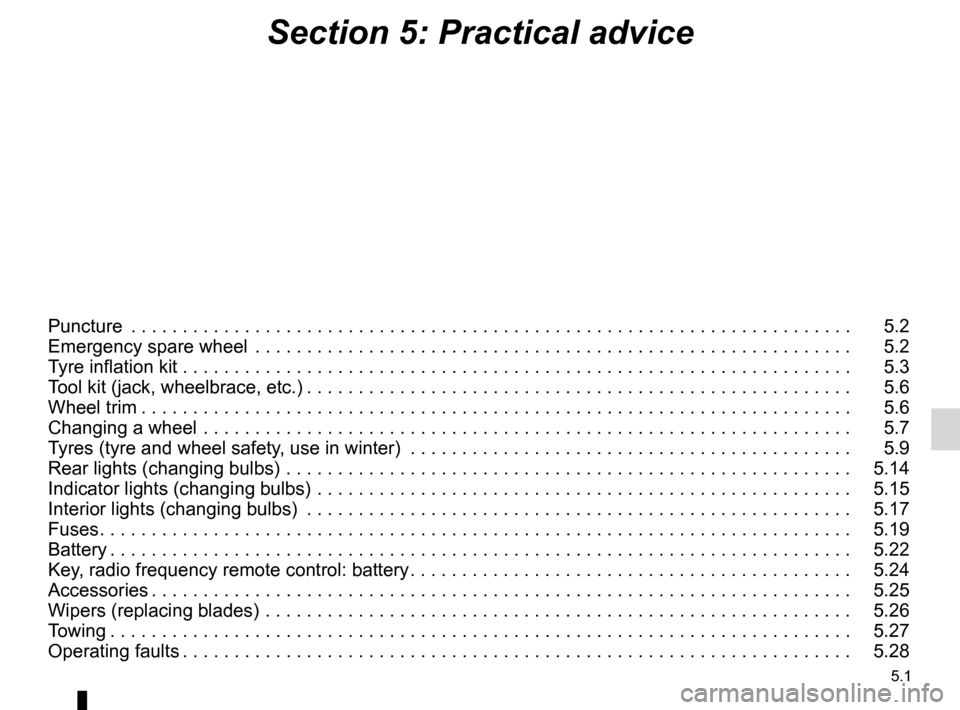
5.1
ENG_UD29999_7
Sommaire 5 (E33 - X33 - Renault)
ENG_NU_865-6_E33_Renault_5
Section 5: Practical advice
Puncture . . . . . . . . . . . . . . . . . . . . . . . . . . . . . . . . . . . . . . . . . . . . . . . . . . . . . . . . . . . . . . . . . . . . . . 5.2
Emergency spare wheel . . . . . . . . . . . . . . . . . . . . . . . . . . . . . . . . . . . . . . . . . . . . . . . . . . . . . . . . . . 5.2
Tyre inflation kit . . . . . . . . . . . . . . . . . . . . . . . . . . . . . . . . . . . . . . . . . . . . . . . . . . . . . . . . . . . . . . . . . 5.3
Tool kit (jack, wheelbrace, etc.) . . . . . . . . . . . . . . . . . . . . . . . . . . . . . . . . . . . . . . . . . . . . . . . . . . . . . 5.6
Wheel trim . . . . . . . . . . . . . . . . . . . . . . . . . . . . . . . . . . . . . . . . . . . . . . . . . . . . . . . . . . . . . . . . . . . . . 5.6
Changing a wheel . . . . . . . . . . . . . . . . . . . . . . . . . . . . . . . . . . . . . . . . . . . . . . . . . . . . . . . . . . . . . . . 5.7
Tyres (tyre and wheel safety, use in winter) . . . . . . . . . . . . . . . . . . . . . . . . . . . . . . . . . . . . . . . . . . . 5.9
Rear lights (changing bulbs) . . . . . . . . . . . . . . . . . . . . . . . . . . . . . . . . . . . . . . . . . . . . . . . . . . . . . . . 5.14
Indicator lights (changing bulbs) . . . . . . . . . . . . . . . . . . . . . . . . . . . . . . . . . . . . . . . . . . . . . . . . . . . . 5.15
Interior lights (changing bulbs) . . . . . . . . . . . . . . . . . . . . . . . . . . . . . . . . . . . . . . . . . . . . . . . . . . . . . 5.17
Fuses . . . . . . . . . . . . . . . . . . . . . . . . . . . . . . . . . . . . . . . . . . . . . . . . . . . . . . . . . . . . . . . . . . . . . . . . . 5.19
Battery . . . . . . . . . . . . . . . . . . . . . . . . . . . . . . . . . . . . . . . . . . . . . . . . . . . . . . . . . . . . . . . . . . . . . . . . 5.22
Key, radio frequency remote control: battery . . . . . . . . . . . . . . . . . . . . . . . . . . . . . . . . . . . . . . . . . . . 5.24
Accessories . . . . . . . . . . . . . . . . . . . . . . . . . . . . . . . . . . . . . . . . . . . . . . . . . . . . . . . . . . . . . . . . . . . . 5.25
Wipers (replacing blades) . . . . . . . . . . . . . . . . . . . . . . . . . . . . . . . . . . . . . . . . . . . . . . . . . . . . . . . . . 5.26
Towing . . . . . . . . . . . . . . . . . . . . . . . . . . . . . . . . . . . . . . . . . . . . . . . . . . . . . . . . . . . . . . . . . . . . . . . . 5.27
Operating faults . . . . . . . . . . . . . . . . . . . . . . . . . . . . . . . . . . . . . . . . . . . . . . . . . . . . . . . . . . . . . . . . . 5.28
Page 150 of 185
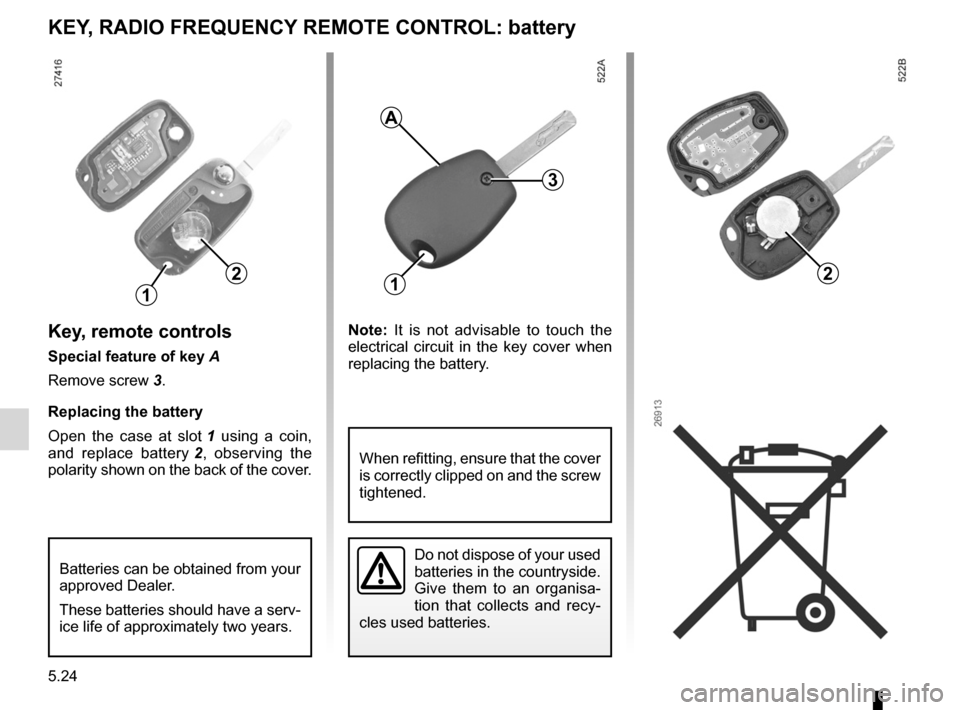
batteries ................................................................. (current page)
5.24
ENG_UD13476_1
télécommande à radiofréquence : piles (E33 - X33 - Renault)\
ENG_NU_865-6_E33_Renault_5
n ote: It is not advisable to touch the
electrical circuit in the key cover when
replacing the battery.
Key, radio frequency remote control: battery
Key, radIO FreQuency remOte cOntrOL: battery
Key, remote controls
special feature of key A
Remove screw 3.
replacing the battery
Open the case at slot 1 using a coin,
and replace battery 2 , observing the
polarity shown on the back of the cover.
Do not dispose of your used
batteries in the countryside.
Give them to an organisa -
tion that collects and recy -
cles used batteries.Batteries can be obtained from your
approved Dealer.
These batteries should have a serv-
ice life of approximately two years.
3
When refitting, ensure that the cover
is correctly clipped on and the screw
tightened.
1
2
3
2
a
1
Page 153 of 185

towingbreakdown ...................................... (up to the end of the DU)
towing hitch ........................................... (up to the end of the DU)
5.27
ENG_UD21756_2
Remorquage : dépannage (E33 - X33 - Renault)
ENG_NU_865-6_E33_Renault_5
Towing
tOWIng : breakdown
the steering wheel must be un -
locked and the ignition key must be
in position m (ignition on) to provide
brake lights and hazard warning
lights on the towed vehicle. at night
the vehicle must have its lights on.
You must observe the towing regu -
lations which apply in the country in
which you are driving.
Contact an approved dealer.
Only use:
– a t the front, towing hitch 3 (lo -
cated in the tool kit).
– at the rear, towing point 5.
These towing points may only be used
for pulling the vehicle, never for lifting it
either directly or indirectly.
– The towing hitch must
only be used for towing your
vehicle.
– It is forbidden to tow other
vehicles.
Do not remove the key from
the ignition when the vehi -
cle is being towed.
5
21
3
4
access to front towing
point 1
Unclip cover 2.
t ighten towing hitch 3 fully: first by
hand until it stops then finish by locking
it with wheelbrace 4.
Towing hitch 3 and wheelbrace 4 are
located in the tool kit.
W h e n t h e e n g i n e i s
stopped, steering and brak-
ing assistance are not op -
erational.
Do not push the vehicle
if the steering column is
locked.
Page 180 of 185

7.2
FRA_UD30001_7
Index (E33 - X33 - Renault)
ENG_NU_865-6_E33_Renault_7
Jaune NoirNoir texte
AlphAbeticAl index (2/4)
Electronic Stability Program: ESP .........................2.10 → 2.12
emergency brake assist ......................................... 2.10 → 2.12
emergency braking ................................................ 2.10 → 2.12
emergency spare wheel ............................................... 5.2, 5.6
engine oil ................................................................... 4.4 → 4.6
engine oil capacity ...................................................... 4.5 – 4.6
engine oil level ........................................................... 4.4 → 4.6
environment ......................................................................... 2.9
ESP: Electronic Stability Program .........................2.10 → 2.12
external temperature ......................................................... 1.49
F
faults operating faults ................................................ 5.28 → 5.34
filter air filter .................................................................... 2.6, 4.9
diesel filter ............................................................... 2.6, 4.9
oil filter .................................................................... 4.6, 4.9
passenger compartment filter ........................................ 4.9
fittings ..................................................................... 3.21 – 3.22
front seat adjustment ......................................................... 1.11
front seats adjustment ....................................................... 1.11 → 1.14
with manual controls .................................................... 1.11
fuel advice on fuel economy ....................................... 2.6 → 2.8
capacity ........................................................................ 1.56
filling .................................................................. 1.56 – 1.57
grade ................................................................. 1.56 – 1.57
fuel economy ............................................................. 2.6 → 2.8
fuel filler cap ........................................................... 1.56 – 1.57
fuel level ............................................................................ 1.38
fuel tank capacity ............................................................. 1.56 – 1.57
fuel tank capacity .................................................... 1.56 – 1.57
fuses ...................................................................... 5.19 → 5.21G
gear lever
............................................................................. 2.5
h
handbrake ................................................................... 1.34, 2.5
hands-free telephone integrated control ............................ 3.26
hazard warning lights signal ................................... 1.51 – 1.52
headlight flashers .............................................................. 1.51
heating and air conditioning system .................................. 3.18
heating system ........................................................ 3.8 → 3.18
horn ................................................................................... 1.51
horn: flash ............................................................................. 1.51
sounding the horn ........................................................ 1.51
hubcap tool .......................................................................... 5.6
i
ignition switch ...................................................................... 2.2
indicators .................................................................. 1.34, 1.51
indicators: direction indicators .............................................. 1.51, 5.14
exterior temperature indicator ...................................... 1.49
instrument panel .............................................. 1.34 → 1.40
instrument panel ........................................... 1.34 → 1.40, 1.52
instrument panel messages ............................................... 1.40
interior trim maintenance ..................................................... 4.14 – 4.15
J
jack ...................................................................................... 5.6
K
keys ........................................................................... 1.2 → 1.4